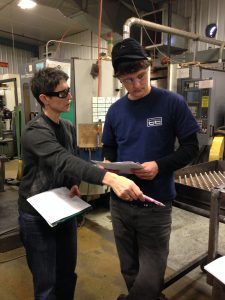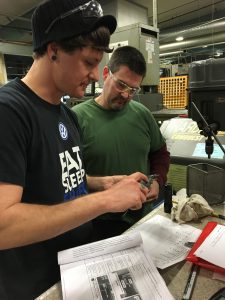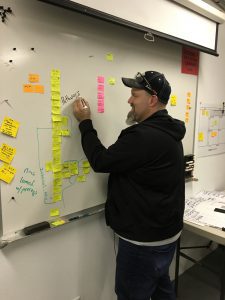Who is A.R.E. Manufacturing?
A.R.E. Manufacturing Inc. (A.R.E.) specializes in using high-end CNC machining equipment to manufacture precision components from various materials. Since its foundation in 1980, A.R.E. has grown from a small garage to an operation with more than 45 employees and a host of equipment including vertical machining centers, horizontal machining centers with pallet systems, and multi-axis lathes with live tooling.
Beginning the Workforce Journey
They began their lean journey several years ago, working to eliminate waste from their workplace and empower their employees to solve  problems. In 2015, OMEP and A.R.E. collaborated to implement a structured on-the-job training program. They saw the need arise as they continued to grow.
problems. In 2015, OMEP and A.R.E. collaborated to implement a structured on-the-job training program. They saw the need arise as they continued to grow.
“We had a program to initiate employees within their first 90 days of employment, but beyond that, people were on their own. Because we didn’t have formalized training for existing employees, opportunities to learn varied too much to stick. We weren’t as consistent as we could have been. Since training wasn’t documented, we had training plan, but had huge gaps. We didn’t measure what you were doing so had no way of tracking success and we relied heavily on more seasoned employees knowledge. It was time to make a change.”
They selected a partner for the project, Rusty, who worked closely with OMEP to define and develop the career paths that will allow employees to move horizontally (cross training) and hierarchically through the organization. To assist him with the training portion of the project, Rusty decided to work with Jarrod. Jarrod is the cell leader of a fabrication team, dealing with daily production flow. He began as entry level employee, and through hard work and dedication, shifted to a leadership position in the company.
Developing and Documenting Employee Job Tasks
 As the Trainer for the Smart Talent initiative, Jarrod was ready to hit the ground running.
As the Trainer for the Smart Talent initiative, Jarrod was ready to hit the ground running.
Over the course of four months, OMEP and A.R.E. built out career paths for employees. Next, they developed documented training for every job in A.R.E. This was Jarrod’s task. He went with and interviewed each level 2 employee to find out how they performed tasks, and they certain steps were taken. Next, he documented their process, breaking down larger tasks into 30 minute increments. To document, he took photos, and wrote notes so that anyone could learn the task.
Training Staff: Immediate Results
Then, it was time for the exciting part. Jarrod gathered employees together and began training staff with the new modules he’d developed. The results surprised them.
“The employees now see a link between their training and the path to future pay increases and other rewards,” Jarrod says. “They look forward to training and see true value in it. They ask me a lot more questions – ‘what’s the next step? What will we learn next?’ There is excitement to get to next module / pathway. The regular checks-ins are very valuable. It gives them the confidence to know that they know what they know. They know what they’re doing and have been tested so they feel good about their knowledge.”
What’s Different?
We asked them what the biggest change has been since A.R.E. began working on workforce issues. Jarrod has reported that he’s become a better trainer. Rusty reports increased employee engagement and a stronger sense of security about the future of his business.
trainer. Rusty reports increased employee engagement and a stronger sense of security about the future of his business.
Before Smart Talent we had band aid type training. If we had a quality or inefficiency issues, we conducted training on the fly to stop the bleeding. Today, we have a formalized training schedule, and every week we run through a set of modules for our employees to gain knowledge. We’re conducting proactive rather than reactive learning.”
- 25% reduction in non-value added activities due to standardization of current processes
- 30% increase in the entry-level hiring pool
- Projected 50% reduction in set-up time
- Projected 50% improvement in employee proficiency (reduction in training time from 5 years to 2.5 years)
ARE’s journey is far from over. The next steps for this collaboration will be to integrate SMART Talent into A.R.E.’s culture, standardize training procedures across products and processes, and empower employees to continue to develop and sustain the program.
Rusty says, “most companies don’t develop their inability to train employees overnight, so you won’t develop an ability to train overnight either. This is a long term process and it is a fluid process that will continue to improve.”
—
SMART Talent is different from other structured on-the-job skills training programs because it provides companies with a proven approach to internal training that quickly integrates new employees and develops incumbents. This program builds training into the regular work day, allowing trainers and trainees to see immediate results, and increase their confidence.
